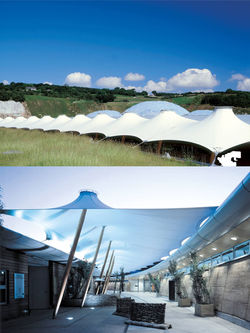 |
|---|
 |
 |
 |
 |
 |
 |
 |
|---|
 |

EDEN PROJECT
Grimshaw Architects, Cornwall, United Kingdom, 2000
MIGHT THE COEXISTENCE OF DIVERSE HABITATS CONSTITUTE A VITAL COMPONENT FOR FUTURE HUMAN SETTLEMENT?
The Eden Project is a giant botanical garden complex dominated by two huge enclosures consisting of adjoining domes that respectively consist of hundreds of hexagonal and pentagonal inflated plastic ETFE cells supported by steel frames. It houses thousands of plant species, with each enclosure emulating a natural biome --- a tropical environment and a Mediterranean environment.
Located on a recouped Kaolinite pit in the southwestern region of England, each enclosure consists of several hemispheric forms fastened together in a boolean addition, eight inter-linked transparent domes. On the one hand, spanning 1.5 hectares and supporting a volume of 330,110 cubic meters the Humid Tropics Biome houses a tropical environment. Conversely, its peer Warm Temperature Biome covers 65 hectares and includes a volume of 85,620 cubic meters with a Mediterranean environment. Spanning approximately fifty hectares the project was completed at the start of the millennium with the main area for the biomes and botanic attractions at fifteen hectares.
With an ethos for innovative structures the design team developed the main biomes from hexagonal panels of tubular steel executed by building envelope specialists MERO. The steel clad panels are triple-layered pillows of ETFE cushions for maximum solar gain and thermal retention, - allowing for light transmission comparable to that of a greenhouse and a thermal barrier suitable to support a much warmer and more humid interior climate within the biomes. Embedded underground heating provides the necessary hot water to circulate warm air throughout the structure via large jets for a consistent interior temperature and humidity for the housed species of plants. In summer months, vents automatically open to relieve interior heat within the biomes, while the tropical biome additionally requires spray misters to maintain appropriate humidity levels. And although off-site water is used for human consumption, a complex wastewater recovery system supplies all the water to maintain the biomes.
The Eden Project was born under the background of a persistent public belief that catastrophe, due to climate change and insufficient resources, is imminent and thus emulates a new technologically equipped type of “spaceship earth,” or a Noah’s ark for the earth’s depleting flora. When such dire immanence project to the field of architecture, our common and admittedly banal use of the word ‘sustainability’ strengthens the development of a most peculiar type of architecture: “one that articulates a unique relationship between architecture and fantasy against a background of immanent catastrophe” (Adams, “Approaching the End,” 97) and eventually commoditizes architectural and construction performance as a selling point for a rising ethos of ecological capitalism.
There is no longer a hiding place from the symptoms of environmental disruption, the severity of climate change, and the loss of biodiversity, yet Eden is neither combatting these conditions, nor constructing a set of construction tools as architectural precautions. What it successfully does is to construct an impressive stage set of our loss and to shield a protective enclosure, which can no longer be part of our natural habitat as a souvenir. Ecological capitalism is an emerging term enabling the capitalization, not necessarily of nature, but of our sense of loss of nature, for the development of new economies. According to Tim Smit, Eden’s Executive Vice-Chairman, and Co-founder, more than 16 million people have come to see what was once a sterile pit turned into a cradle of life, containing world-class horticulture and startling architecture symbolic of human endeavor. Eden has contributed over £1 billion into the Cornish economy.
KEYWORDS: ETFE, Ecological Capitalism
KEY FAILURES
OFFSITE WATER: 2008 launch of forty rats – a simulation of the oxygen demands for one human – enabled researchers to observe that it was not possible to meet target goal of one-hundred percent oxygen closure.
